Adam Yamey's Blog: YAMEY, page 36
October 19, 2024
Grey sky on a Sunday morning in Chelsea
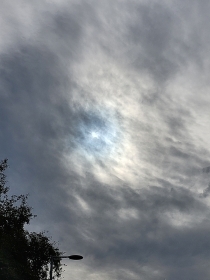
There is a grey sky over Chelsea Old Town Hall this cold Sunday morning in October. The sun is trying to penetrate the clouds. Will it succeed? We hope so, but possibly we are being over optimistic.
October 18, 2024
I have not seen one like this before
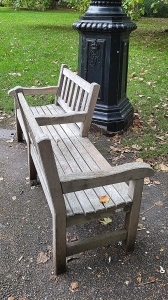
While strolling through London’s Green Park, I came across the bench illustrated above. It looked quite new, and is an unusual design, which I have never seen before. It can accommodate four adults providing they are all fairly slim.
October 17, 2024
Images of urban life in India
BORN IN PUNE (Maharashtra, India) in 1949, Sudhir Patwardhan qualified as a medical doctor in 1972. He worked as a radiologist in Thane (Bombay) between 1975 and 2005. Then, he moved from medicine to become a full-time artist. Until the 19th of October 2024, there is an exhibition of his paintings at number 3 Cork Street in London’s Mayfair.
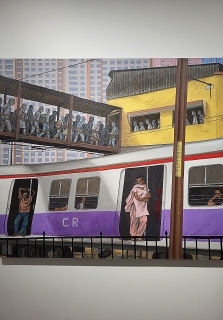
The exhibition is called “Cities: built, broken”. As its name suggests, the show is filled with Patwardhan’s paintings, each of which depicts scenes of urban life. His beautifully executed, colourful paintings evoke daily life in Thane and Bombay (Mumbai). As the gallery’s website (www.frieze.com/no9-cork-street/vahder...) explained:
“As a man of medicine, Patwardhan displays a profound understanding of the human figure, including its mental distortions and physical vagaries, with early inspiration from Cézanne and Picasso refining his intent. In this recent body of work, Patwardhan’s well-regarded visceral realism explores various dialectics and asymmetries, including class struggles, tensions between the material and spiritual and the emotional theatre of community. The shifting deportment of his figures across a series of charged slice-of-life scenes offers a moving portrait of the bustling annals of cities, where capitalist consumption, gentrification and the erosion of natural spaces are but few of the contested arguments about what constitutes as urban progress. He brings us a visual meditation on the geometric correspondences between various kinds of structures growing out of anarchic infrastructural development – often referred to colloquially in India as jugaad, or a kind of organized chaos.”
I could not have put this better. It describes the subject matter of the paintings beautifully. However, rather than just reading about it, I suggest that you see these wonderful paintings before the exhibition ends.
October 16, 2024
Chairs, coronations, and royalty
BASILDON PARK IS an 18th century neo-classical mansion not far from Reading. From 1949, the house was owned and restored by the 2nd Baron and Lady Iliffe. They lived in it for 25 years. In one room on the ground floor, which contains the fascinating sketches made by the artist Graham Sutherland for his tapestry in Coventry Cathedral, there are four chairs. Two of them have the insignia of King George VI embroidered on their covers, and the other two are embroidered with the insignia of Queen Elizabeth II.
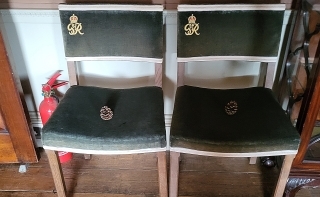
A National Trust volunteer guide working in the house explained that the 2nd Baron and his wife had attended the coronations of both King George VI and Queen Elizabeth II. The chairs were those they had sat on during these ceremonies. After the coronations, so the guide told us, the Iliffes bought the chairs they were sitting on to keep as souvenirs. The proceeds of sales such as this helped to pay for the coronation events.
Seeing these chairs reminded me of another chair, which I saw in a cousin’s house in Cape Town, South Africa. It was in this chair that Queen Mary (wife of King George V) had sat for a few minutes when she paid a brief visit to the Mayor’s house in King Williams Town (now called ‘Qonce’) in South Africa in 1946. The Mayor was my mother’s uncle. His grandson, my cousin, has kept this souvenir of the royal visit. I saw it when I visited him in Cape Town. Unlike the chairs at Basildon Park, there is no royal insignia on it.
October 15, 2024
The azulejo tiling of Portugal is moving onwards
ONE OF THE CHARMING aspects of Portuguese culture is the use of the mainly blue and white decorative tiling known as ‘azulejo’. It can be found in Portugal and wherever else the Portuguese had colonies. One of the former colonies was Brazil. It was there that the artist Adriana Varejão was born in 1964 (in Rio de Janeiro). Today (the 11th of October 2024), at the Frieze Masters art show in London’s Regents Park, we saw a fine exhibition of her works in the booth set up by the Victoria Miro Gallery.
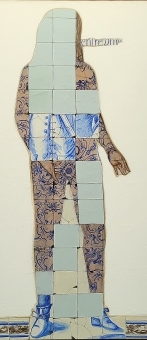
It was fascinating to see how Adriana subverts the azulejo, which was introduced to what is now Brazil by its Portuguese conquerors. Clearly inspired by the traditional tiling, her works both refer to it and distort the technique to create attractive, imaginative artworks that allude to the distortive effects of colonialism on indigenous culture.
I love seeing traditional azulejo. Seeing Adriana’s work was particularly enjoyable given that, to use a well-worn expression, ‘I know where she is coming from’. And I like the way that she has been moving the age-old art of azulejo into pastures new.
October 14, 2024
An artist from India in London’s St Johns Wood
THE BEN URI gallery in was established in 1915 in London’s East End. Named in honour of Bezalel Ben Uri, the craftsman who designed and built the Ark of the Covenant, it moved to Boundary Road in St Johns Wood in 2002. Originally, it was a place where Jewish immigrant artists and craftsmen could display their work. More recently, it has widened its remit to feature artists of all religions, who have migrated to Britain from other countries.
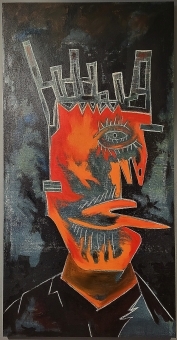
Until the 29th of November 2024, the gallery is holding an exhibition of works by an artist born in Goa (part of India since 1961): Lancelot Ribeiro (1933-2010). He came to England to study accountancy in 1950. He disliked the subject. At first, he lived with his half-brother, the artist FN Souza. Later, he resided in Hampstead. In 1951, he began studying art at St Martins School of Art, where my mother created sculpture between 1950 and the mid-1960s. The exhibition at the Ben Uri focusses on Ribeiro’s work in the field of portraiture, and displays his innovative and imaginative approach to this form of art. The exhibition is small but well displayed. I felt it was a more satisfactory showing of Ribeiro’s art than the exhibition that was held recently at Hampstead’s Burgh House.
October 13, 2024
Cyclamen in October

Even though it is October and the leaves are changing colour on the trees before being shed by them, cyclamens are blooming as if spring has just arrived. Nature never ceases to amaze.
October 12, 2024
Setting the table at a grand house in Berkshire
BASILDON PARK IS an 18th century country house in Berkshire. Managed by the National Trust, it is open to the public. The dinner table in its grand dining room was set as it would have been in Victorian times, so a guide explained to us.
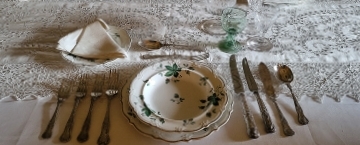
The centre of each place setting is a soup bowl resting on a plate. To the left of it, there are four forks, and to its right there are three knives and a spoon. Above the plates, there is a dessert spoon and fork. Working from left to right, the forks are for seafood (often oysters), fish fork, starter fork, and then closest to the plates, main course fork. To right of the plates, working from right to left, there is a soup spoon, a fish knife, a starter knife, and the closest to the plates, a main course knife. Each place setting had four drinking glasses: sherry, white wine or champagne, red wine, and port. We were told that there was no cutlery for cheese because in the 19th century, cheese was not served at formal dinners. What I have described was typical of a Victorian table setting in a grand country house such as Basildon Park.
In the early 1990s, we were invited for lunch at a friend’s house. Each of the table settings was almost as elaborate as that which I have described above. I looked at the table, and expected that we were about to be served a multi-course feast. The first course was pasta. I was seated so that I was able to see the kitchen. I noticed that there was a light on inside the glass-fronted oven, but it was empty. When our host offered second helpings of the pasta, everyone, doubtless expecting that much more food would be arriving, declined the offer. I was the exception, and said I would love some more. That is because, having seen the empty oven, I was more realistic about the future course of the meal. I was served my second helping, and then a bowl of salad was passed around. After that, the meal was over. However, we had only used a small proportion of the cutlery laid out at each place setting. To this day, I have been puzzling over the elaborate place settings when only one course was served. Seeing the table at Basildon Park reminded me of this occasion.
October 11, 2024
How I discovered the author Margery Allingham
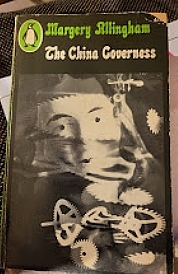
IN 1965 I HAD to apply for admission to secondary school. As part of the preparation for this, the headmaster of my preparatory school (The Hall in London’s Swiss Cottage) interviewed each of the pupils who were ready to apply for admission. I was one of them. With some trepidation, I met him in his office. One of the questions he asked was: “What do you read?”. I answered: “Thrillers”. Then he asked me which thriller writers I liked. I answered: “Ian Fleming. I enjoy the James Bond stories.” Mr Cooper, the headmaster, seemed upset by my response. After a moment, he asked: “Don’t you read Margery Allingham?” I had never heard of her, and when I told him this, I felt that he thought I was a ‘lost cause’. Now, 59 years later, I have not yet read any books by her, but thanks to Mr Cooper, I have known about her for a long time.
October 10, 2024
The granddaughter of a famous author in a church in Oxfordshire
ONE WRITER WHOM I had to study for a state examination in English literature in 1968 was Geoffrey Chaucer (c1343-1400). Although I struggled to make sense of his “Prologue” to the Canterbury Tales, I enjoyed doing so. Since then, I have hardly ever thought about Chaucer. This changed when we made our third visit to the attractive village of Ewelme in Oxfordshire. During this visit, the parish church (St Mary) was open, and we were able to enter. Inside, we met a churchwarden, who was getting the place ready for a funeral service. He pointed out a very elaborate tomb that separates the chancel from the Chapel of St John the Baptist, which occupies the southeast corner of the church. I could hardly believe my ears when he told me whose remains are buried beneath this tomb.
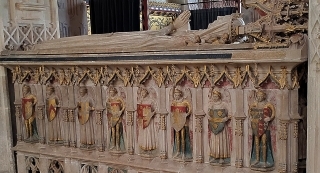
The tomb, which bears the carved stone effigy of a woman, and beneath it, a stone carving depicting her after death, is that of Alice, the Duchess of Suffolk (1404-1475). She had been married first to the Earl of Salisbury, who died in 1428. Her second husband was William de la Pole (1396-1450), 4th Earl and first Duke of Suffolk. Fascinating though this is, what really interested me was that her paternal grandfather was none other than Geoffrey Chaucer, whose writing I studied many years ago. Near to Alice’s tomb, there is a less elaborate tomb containing the remains of her parents, Thomas Chaucer and Maud (née Burghersh).
Once again, visiting places in the English countryside has led us to making an exciting discovery.



